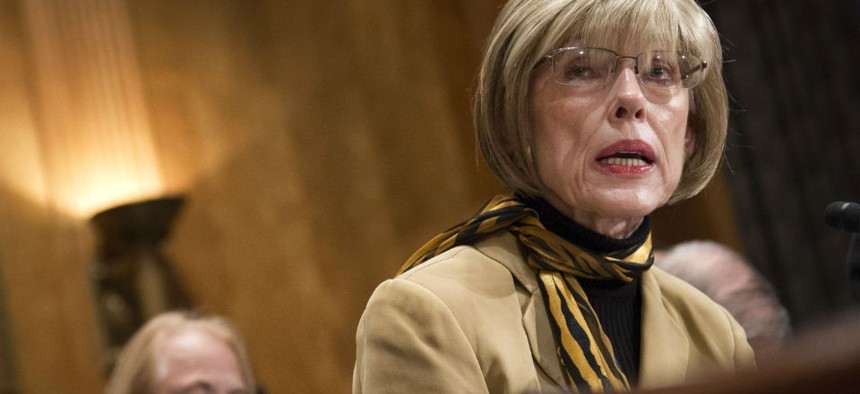
Judy Rivers of Logan, Ala., testifies about her mistaken inclusion on SSA's Death Master File. Cliff Owen/AP
Getting the Living Off Social Security’s Deceased List May Take Legislation
Alabama woman testifies on being reduced to poverty after erroneous designation.
Congressional testimony seldom gets more powerful than a first-hand account from a living victim whom the government had long declared dead.
The tale of woe from witness Judy Rivers of Logan, Ala., on Monday combined with reform proposals from agency officials to produce rough consensus within a Senate panel that widely reported errors in the Social Security Administration’s Death Master File may be fixed only through new legislation.
Following a scathing Government Accountability Office report and a “60 Minutes” segment about millions of people as old as 112 being counted as living, Rivers described how her wrongful inclusion on the Death Master File used by many agencies and businesses left her unemployed and living in her car or a camper owned by church friends. She had formerly earned a six-figure salary.
“I only found out that it happened in the last couple of weeks that I was actually listed on the Death Master File in 2008,” Rivers told the Senate Homeland Security and Governmental Affairs Committee. Without a Social Security number, “you can’t buy a cell phone,” enroll in an online school for recertification or open a savings account,” said the woman, who was also taking care of elderly parents and dealing with insurance companies following a car accident.
“I went to the Social Security office and was told all is fine,” she added, describing fruitless visits to credit bureaus and the Internal Revenue Service (whose National Taxpayer Advocate Nina Olson, Rivers added, at least gave her good advice).
“If I had been a victim of identity theft, that would have triggered a police investigation and I’d have known,” Rivers said. “The Death Master File is a bad database. You solve one issue and another pops up. An agency other than the Social Security should be put in charge so it can control it.”
The hearing, titled, “Examining Federal Improper Payments and Errors in the Death Master File,” is part of a broader examination of the government’s ongoing effort to cease writing checks to unqualified beneficiaries. After five years of progress, the estimated improper payments total was recently reported to have risen last year.
“Washington is the capital of unintended consequences,” Sen. Ron Johnson, R-Wis., said in thanking the star witness. “The Social Security Administration is currently part of the problem that leads to payments to dead people. With a little common sense and relatively minor capital investments, SSA can take action that will prevent payments to the deceased for the entire federal government.”
But Sean Brune, senior adviser to SSA’s deputy director for budget, finance, quality and management, said the issue is more complicated. Though as many as 9,000 Americans per year are mistakenly declared dead, “program integrity and the stewardship of trust fund and tax dollars have long been a cornerstone of SSA’s mission,” he said. “The death information we collect serves us well and prevents around $50 million each month from becoming improper payments. Further, of the around 2.8 million new death reports we add to our records each year, less than half of 1 percent—just 0.35 percent—are erroneous” due either to data entry mistakes or faulty reporting by funeral directors and families of beneficiaries.
The most reliable source for data is the states’ official records offices, Brune said, and the best way to ensure accuracy is for more states to use the Electronic Death Registration system, now deployed by only 37 states, the District of Columbia and New York City.
U.S. Controller David Mader said, “There is compelling evidence that investments in administrative resources can significantly decrease the rate of improper payments and recoup many times their initial investment.” He cited the Obama administration’s steady reduction of the error rate from 5.42 percent in 2009 to 3.53 percent in fiscal 2013, before the fiscal 2014 rate rose in some but not all programs. He called for increasing the budget of the Internal Revenue Service and improving the Labor Department’s data matching capabilities in verifying eligibility for reemployment aid.
Echoing Brune, Mader recommended legislation and proposals in President Obama’s 2016 budget to widen sharing of available death data across government agencies. Particularly, Congress should change current laws forbidding the Treasury Department from using SSA’s death data in its Do Not Pay initiative to curb improper payments, he said. (S. 614, introduced by ranking member Sen. Tom Carper, D-Del., and co-sponsored by Johnson, would do so.) Asked by Sen. James Langford, R-Okla., whether SSA is the best agency to run the Death Master File, Mader said “yes.”
Inspector General Patrick O'Carroll Jr., whose audits triggered the controversy, commended SSA’s use of cross-checks, among them automatically contacting personally all Social Security beneficiaries who turn 100, and monitoring elderly beneficiaries who never use Medicare. He also suggested legislation enacting the goal shared by many inspectors general that the 1988 Computer Matching and Privacy Protection Act be softened to allow more inter-agency sharing of sensitive records to ferret out waste and fraud.
Brune was asked by Sen. Kelly Ayotte, R-N.H., whether SSA could redirect some funds toward verifying its own questionable reports of death or the absence thereof that other agencies need. Under the law, “we are not permitted to spend trust fund dollars on non-program purposes,” Brune replied.
Sen. Claire McCaskill, D-Mo., requested cost estimates on how agencies that use the Death Master File could reshuffle their fee practices. The Commerce Department’s National Technical Information Service, which sells only partially updated lists to businesses, “has outgrown its usefulness,” she said. “They price out what agencies make by sharing.”
NEXT STORY: Building Inclusive Diversity: More Than Numbers







